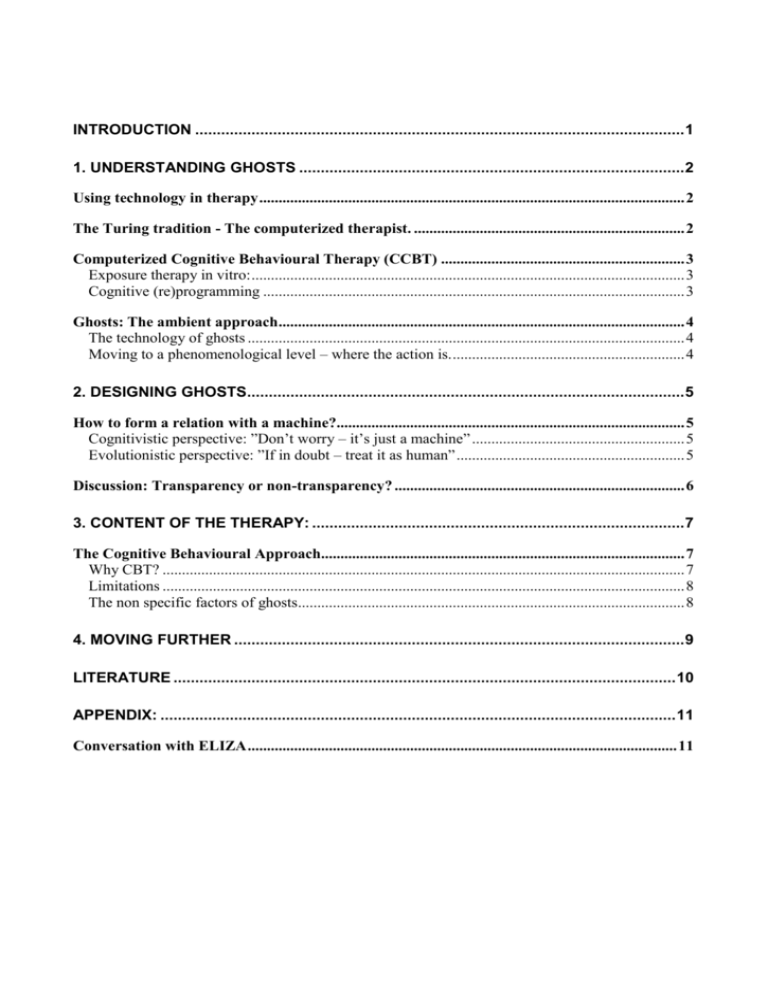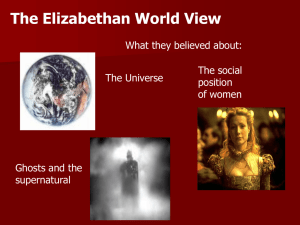3. Content of the therapy
advertisement

INTRODUCTION ................................................................................................................. 1 1. UNDERSTANDING GHOSTS ......................................................................................... 2 Using technology in therapy .............................................................................................................. 2 The Turing tradition - The computerized therapist. ...................................................................... 2 Computerized Cognitive Behavioural Therapy (CCBT) ............................................................... 3 Exposure therapy in vitro: ................................................................................................................ 3 Cognitive (re)programming ............................................................................................................. 3 Ghosts: The ambient approach ......................................................................................................... 4 The technology of ghosts ................................................................................................................. 4 Moving to a phenomenological level – where the action is. ............................................................ 4 2. DESIGNING GHOSTS..................................................................................................... 5 How to form a relation with a machine?.......................................................................................... 5 Cognitivistic perspective: ”Don’t worry – it’s just a machine” ....................................................... 5 Evolutionistic perspective: ”If in doubt – treat it as human” ........................................................... 5 Discussion: Transparency or non-transparency? ........................................................................... 6 3. CONTENT OF THE THERAPY: ...................................................................................... 7 The Cognitive Behavioural Approach.............................................................................................. 7 Why CBT? ....................................................................................................................................... 7 Limitations ....................................................................................................................................... 8 The non specific factors of ghosts.................................................................................................... 8 4. MOVING FURTHER ........................................................................................................ 9 LITERATURE .................................................................................................................... 10 APPENDIX: ....................................................................................................................... 11 Conversation with ELIZA ............................................................................................................... 11 Can Ghosts Do Therapy? By: Anders Colding-Jørgensen Introduction In late October, 2004, I received a call from lic.psych, John Paulin Hansen at ITU (the ITUniversity in Copenhagen) who is in charge of a research activity, called DELCA. ”DELCA stands for "DisEmbodied Location-specific Conversational Agents" [ … ] The DELCA project involves the design of intelligent creatures known as ghosts. The DELCA ghosts are highly emotional creatures, which can assist and entertain you in variety of ways. Some ghosts can guide you around in the buildings, find specific locations etc. Other ghosts can play or generate music upon requests. Some ghosts can monitor and surveil your car, while others can help you solve problems with computers such as finding right printers or entertain you with games.” The DELCA website ( http://delca.dk ) I was offered a research internship at ITU’s Institute of Innovation, with the explicit goal to investigate the possibilities of using the DELCA ghosts to help people with mental and behavioural problems, such as phobias or emotional disorders. After a meeting, I agreed to actually design such a ghost and run a live project, which I would use as the basis for my master thesis. Thus, I will be working for a full year from February, 2005 with researching, designing and bringing to life (or to where ever ghosts are brought) a mental health ghost. The project will also serve as a framework for experimenting with different methods. In this paper, I will attempt a first outline of a basic framework for understanding and working with the so called ghosts in treatment of mental disorders. However, this paper is not about technology, it is about the challenges to the practice and science of psychology that arise with the emergence of new tools in our environment. As I have researched the topic in the past months, it is not the differences, but the similarities between building a therapeutic and a technological space, that have become apparent. Thus, this paper is about building spaces and the two questions I will address in this paper are questions that can be applied to all kinds of therapy. The questions are: 1) How can a ghost therapist be understood and devised? 2) What kind of therapy can such a ghost provide and how can it be implemented? 1 Can Ghosts Do Therapy? By: Anders Colding-Jørgensen In this text, I will address the fundamental problems with introducing a technological tool in a therapeutic context and finally suggest compatibility with cognitive therapy. At my oral presentation, I will present and discuss a specific example of the application of ghosts in the practice of therapeutic intervention and the research issues that arise from it. 1. Understanding ghosts Using technology in therapy Using technology as a tool is an everyday thing in therapy. As a natural thing, we communicate with potential clients on the phone or via email – to make an initial assessment, to give advice or to simply make an appointment. Perhaps we will make a recording of a session on an audio tape for the client to listen to at home. We may also run a search on the internet to gain information about the solutions others are using or exchange thoughts with colleagues. Thus, it is not the question if we should use technology – but what and how. Even though it may be seen as just a natural development, actually recruiting computers to do therapy is clearly a more radical implementation of technology. But even that is not a novel invention. The Turing tradition - The computerized therapist. As long as computers have been able to create a text output based upon an input, people have been fascinated by the thought of making a computer program that could appear intelligent – at least o a degree where it could fool someone into believing that they were communication with a real person. The challenge was captured back in 1950 in, with the famous Turing test. In the Turin test, a human interrogator is given the task of, within 5 minutes, determining whether an opponent – with whom he can only communicate trough typewritten messages, is a human or a machine. If the interrogator can not tell which is which, the machine passes the Turing test (McIlvenny, 1990, Turkle, 1996). The Turing test established a tradition, making it the ultimate challenge for system developers to create conversational systems that appear as if they were human. The step from here to attempting to develop a computerized therapist was obvious. 2 Can Ghosts Do Therapy? By: Anders Colding-Jørgensen The most famous computerized therapist is, without doubt, ELIZA (Turkle, 1996). ELIZA (developed by Wallace/Punlod in 1971) is a very primitive computer program, which emulates a Rogerian therapist by continuously feeding the client’s last words back to her as questions. I went to a website running a copy of ELIZA and initiated a session with her, just to provide an example (Appendix A). The ”humanoid” approach has been taken even further in projects like Weintraubb’s ”PC Therapist” from 1986. In a Turing test in 91, which was limited to a single conversational topic, PC Therapist scored best amongst all the participating systems by fooling 50% of the interrogators (Turkle, 1996). From the website of ”Thinking Software”, the PC therapist is now being sold as: ”A lot of fun for youngsters and a great way to enliven any party” ( http://thinkingsoftware.com ). I think this just about sums up where the humanoid synthetic therapist stands today. Computerized Cognitive Behavioural Therapy (CCBT) Exposure therapy in vitro: A completely different approach to computerized therapy has emerged as computers have become graphically advanced enough to present convincing simulations of real environments. Virtual Reality Exposure Therapy, which is being carried out at Georgia Institute of Technology, is classic ”flooding” therapy, where a computer system is used to create a simulation of reality – for instance an elevator setting. The client then ”rides” the simulated elevator, thus being exposed to the anxiety provoking stimuli. In classical behavioural theory, the client will – providing she perceives the synthetic elevator as similar to a real life experience – become habituated and eventually the mind will stop reacting to the stimuli (Gleitmann, 1991; Rosenhahn/Seligman 1995; Basoglu, 2003). Source: http://www.cc.gatech.edu/gvu/virtual/Phobia/phob Cognitive (re)programming An other example of CCBT is the ”self esteem games”, that seem to attempt a kind of positive programming at the level of automatic thought. Based upon the assumption that exposing people to positive facial expressions will influence their thinking about themselves, they have created a computer game, where a photo of a neutral face changes into a bigger version of the face, with a big smile on it, when the user clicks on it. (Dandeneau/Baldwin, 2004) Source: http://www.selfesteemgames.mcgill.ca/research/eyezoom.htm 3 Can Ghosts Do Therapy? By: Anders Colding-Jørgensen Ghosts: The ambient approach The technology of ghosts At a technical level, ghosts are computer programs that know where you are and can speak to you. They run on a central server, in a way similar to web pages. In the pilot project, you will be communicating with ghosts by wearing a small portable mini computer (a so called PDA) and an ear plug. When you enter an area that has been ”wired for ghosts”, the ghost server will know where you are, by registering the signals from your PDA. When a ghost knows where you are, it can start communicating with you, following the rules that are programmed into the ghost-program and taking your exact location into account. When the ghost communicates with you, it uses a synthetic voice, that speaks friendly in your earplug (via text to speech). You can then answer the ghost by speaking directly (voice recognition) or tapping data on to the keypad of the PDA. At a technical level, developing a ghost is developing the rules the ghost should follow, when interpreting the knowledge of your whereabouts and the things you tell the ghost. Moving to a phenomenological level – where the action is. I would like you to forget the computers, the PDA and the ear plug for a while and explore the ghosts at a phenomenological level for a while. Imagine that a ghost is not located in a computer in a pocket, but is ambient – residing at a physical location – e.g. the canteen, by the entrance or in the elevator and will only hear you and speak to you, if you are there, physically. Perhaps a friendly ghost is waiting out side the canteen to support you in overcoming your social anxiety and actually getting some food today. The ghost is still merely another technological tool, but what distinguishes ghosts from all other computerized systems is that they are not fixed at a specific location. In stead of working with the client’s problems in vitro, ghosts can work with them in vivo. Ghosts can be where the actual problems arise. This raises some practical questions: What will the ghost tell you? How will it present itself? Which kind of ghost would you like the best? What would be helpful? As you perhaps notice, the questions on this level, are not at all technological. They are the questions psychologists face every day when building therapeutic spaces. Where shall we meet the client? How should we communicate with her and what will be helpful? 4 Can Ghosts Do Therapy? By: Anders Colding-Jørgensen 2. Designing ghosts How to form a relation with a machine? Forming a therapeutic relation that doesn’t require active suspension of disbelief can be a challenge – even in ordinary therapy. Moving the function of the therapist to a technological system certainly doesn’t make the problem smaller. I view this as a fundamental question: how does one create a synthetic therapist, that anyone would actually want to form a relation with? Even if the goal is not to create a convincing humanoid (we really don’t want to create another PC Therapist!), I find it desirable to create something a bit more warm and friendly than a calculator, especially, if this could evoke some of the non-specific factors, known from therapy in general. Cognitivistic perspective: ”Don’t worry – it’s just a machine” Accepting computers as social actors, has initially been seen as a sign of cognitive immatureness, that could be overcome (Reeves & Nass, 1996). I think this is the view held by people in general. In this piagetan view, computers – because they seem to have humanoid qualities, such as communication and responsiveness - are assimilated into the mental schemata that holds ”living things” by the child. (Miller, 1993). In ”Life On The Screen” (1996), Sherry Turkle claims that the increasing complexity of applications, which is hiding the system quality and making systems present themselves as opaque simulations (rather than transparent constructions) in it self is making it easier for everyone to start talking with them - despite the fact that they know computers are not really alive. However, this is still a cognitivistic argument, since it implies that we would stop talking to systems, if they presented themselves as systems, rather that as simulations. Sherry Turkle holds a Ph.D. in personality psychology. Cognitivistic position: As computers become less transparent and start hiding their technical structure of functioning, we will start accepting them as social actors. As a consequence, a ghost should be designed as a non transparent simulation. Evolutionistic perspective: ”If in doubt – treat it as human” Reeves and Nass – who have approached the problem from a communications perspective - present a different – and far more provocative view in ”The Media Equation” (1996). Here, it is claimed 5 Can Ghosts Do Therapy? By: Anders Colding-Jørgensen that systems do not have to hide their functional structure to evoke responses, much similar to the way we respond to other humans. The basic assumption is biological – or should we say: evolutionistic. According to Reeves and Nass, the human brain is millions of years old and not adjusted to decode media. Therefore, it simply treats a system that starts to communicate with it as another human by default. The ”media equation” refers to the logical statement: media equals real life. According to Reeves and Nass, computers are instinctively and unconsciously perceived as social actors. Reeves and Nass have replicated a series of classic cognitive/social psychology experiments, but replaced one of the social actors with a computer. Even though some of their work raises problems, both in their interpretations and their basic assumptions, their research suggests that users will e.g. think better of a computer (as well as of their own interactions with it) if the computer is polite, praises them and presents a personality style, similar to their own. Even if the computer simply communicates via a simple text interface! Evolutionist position: Even if computers look and act like computers, we will instinctively treat them as social actors, because our brains are not built to distinguish between media and real conversation. As a consequence, transparent ghosts can actually function as credible social actors. Discussion: Transparency or non-transparency? While the instinctive assumption would be that the most efficient ghost design would be the one that (who?) looks the least as a machine – this might not be the case. A technical argument for taking a transparent approach to ”therapist building” comes from Dr. Albert Schmidt from University of Lancaster: At a conference at ITU, 30.11.04 he pointed out that systems that are totally opaque only allow users to interact meaningfully with them at an implicit level. At an explicit level, only a somewhat transparent interface allows for meaningful interaction. An example: Automatic doors in an elevator aren’t normally something we use explicitly. We enter the elevator – they close. But sometimes we need to short circuit the system in order to keep the door open. Because the system is transparent (it works with a photo cell – we can see it) we can easily block the doors, by blocking the beam of light - without having to cause damage to the system. A ghost will initially be quite a clumsy therapist – thus, the client may often need to short circuit the logics of the system to make it work in e meaningful and helpful way. 6 Can Ghosts Do Therapy? By: Anders Colding-Jørgensen Again, we see the obvious analogies between building therapeutic and technological spaces: The client can engage in therapy and ”use” the therapist implicitly, but should the client also be allowed to see the therapist as a human being? The psychoanalyst would vote for non-transparency, just as the humanistic and existentialistic therapists would argue that the therapist-as-a-person is also a strong and important actor in therapy (Seligman/Rosenhahn, 1993; Yalom, 1980; Gleitmann, 1991). (We could also ask an old school behaviouristic therapist, but he probably wouldn’t understand the question) Attempts to create a humanoid, non-transparent, computerized therapist have not been successful – their potential seems to lie mainly in entertainment. Human communication is far too complex, creative and dynamic to be understood and emulated by present-day machines. Furthermore, this approach is based upon deception, which does not seem like a sound – or authentic - basis for any kind of therapy. Finally, the non transparent ghost deprives clients of the possibility to short cut the ghosts behaviour and work with it explicitly, which renders the client a passive recipient. As an alternative framework, which does not require suspension of disbelief, the path suggested by the work of Reeves and Nass seems more fertile. Here, ghosts do not have to present themselves as human, as long as they follow common social rules. This opens up for both explicit and implicit interaction as well as all kinds of non-humanoid ghost designs. At this point in my investigation my conclusion is that a transparent design framework is better, because it is more flexible and empowers the client. 3. Content of the therapy: The Cognitive Behavioural Approach Why CBT? In my view, CBT’s strengths lies in its pragmatic focus on goal setting and problem solving in the present and the immediate future. Furthermore, both assessment and evaluation has strong quantitative components, making them directly compatible with the way a ghost work. An example is the baseline. By creating a baseline, the client is encouraged to measure her own internal state as well as the therapeutic progress on a scale from 0 to 10. (Berliner et al 2004). Another example is 7 Can Ghosts Do Therapy? By: Anders Colding-Jørgensen the problem list. Tasks can be explicated in form of a ranked problem list (as presented by Lone Jacobsen, 04.11.04 at RCT). Computers really like numbers and lists. Because ghosts are ambient, they can provide in vivo support in remembering tasks, encouraging, motivating and feeding back progress. Because they are extremely structured by nature, they may even be the ideal tool for working with graded task assignment (Beck, 1997). Ghosts will be able to actually measure progress – e.g. by objectively measuring the amount of time the client managed to spend in a crowded area, and feed progress back to the client in an authoritative way: ”You have been in the canteen for 45 minutes now – I guess you are feeling quite good today. You are doing great!” Based upon some of the feedback I have received since I started with this project, I feel a need to stress, that I do not suggest ghosts to be used as substitute therapists. Rather, I suggest that the ghost is introduced to the client as a tool in the initial cooperative goal setting between therapist and client. Limitations The limitations of computers have been discussed above, but cognitive therapy also has its obvious limitations: Even though the cognitive approach presents itself as an alternative to Freudian therapy (Beck, 1979), it still views the client as a container, with problems inside. The therapeutic goal is explicated as “cognitive modification” of the client (ibid). The main weaknesses of such an approach is its inability to work at the level of social systems or structural problems. Cognitive therapy has a focus upon irrational thoughts (see for example: Beck, 1979; Berliner et al 2004; Seligman/Rosenhahn, 1995), but some times negative thoughts may be a quite rational reaction to complex social or societal problems, making it useless, at best, and perhaps even harmful to reduce a problem to the client’s thinking about herself. The non specific factors of ghosts Looking at the basic interventional model, suggested by Beck, we find three areas that are interrelated: Improved performance -> elevation of self esteem -> increased motivation -> improved performance (Beck, 1997). Providing a structural aid for graded task assignment can lead to improved performance, feeding back actual progress can lead to elevation of self esteem. This should lead indirectly to an increased motivation. But the ghost in itself could actually be designed 8 Can Ghosts Do Therapy? By: Anders Colding-Jørgensen to be a lot of fun to play with, and therefore raise the motivation directly. Perhaps the greatest strength of ghosts may even be that they can actually add an aesthetic dimension to therapy. 4. Moving further In this paper, I have discussed the basic framework for building a therapeutic ghost, and found that ghosts do not have to present themselves as non-transparent, humanoid agents. Actually, this may actually make them less useful as “relational artefacts”. Furthermore, I have pointed out the compatibility between the computer’s functioning and some of the core tools from the CBT framework. In my oral presentation, I will outline an actual ghost design, that incorporates the methods of cognitive-behavioural therapy in a real-life setting and discuss its strengths and weaknesses. Furthermore, I will present some core research topics that arise from the ghost approach. 9 Can Ghosts Do Therapy? By: Anders Colding-Jørgensen Literature 1. The obligatory literature for the course is included 2. Individual literature list: Beck, A. (1979) Boden, M.A. (ed) (1989) Artificial Intelligence in Psychology. The MIT press Gleitmann, H. (1991) Psychology. Norton Luff, P., Gilbert, N. & Frolich, D (1990) Computers and Conversation. Academic Press Miller, P.H. (1993) Theories of Developmental Psychology. Freeman Pollock, J. (1989) How to build a person. The MIT press Reeves, B. & Nass, C. (1996) The Media Equation. Cambridge University Press Rosenhahn, D.L. & Seligman, M.E. (1995) Abnormal Psychology. Norton Turkle, S. (1996) Life on the screen – identity in the age of the internet. Weidenfeld & Nicholson 10 Can Ghosts Do Therapy? By: Anders Colding-Jørgensen Appendix: Conversation with ELIZA > Hello, I'm Eliza * hi, eliza > How are you today.. What would you like to discuss? * I some times feel anxiety > Tell me more... * when I go to public places, I really freak out > Have you asked such questions before? * no > Why no? * I was afraid, no one would like me > OK... "when you go to public places, you really freak out". Tell me more. * it started when I was 16 > Are such questions on your mind often? * every day > OK... "it started when you were 16". Tell me more. * I was with some friends, and my heart just started to beat > What does that suggest to you? * I felt that I was dying > Can you elaborate on that? The conversation will go on for as long as the user feeds the system with sentences. Source: http://www.manifestation.com/neurotoys/eliza.php3 11






